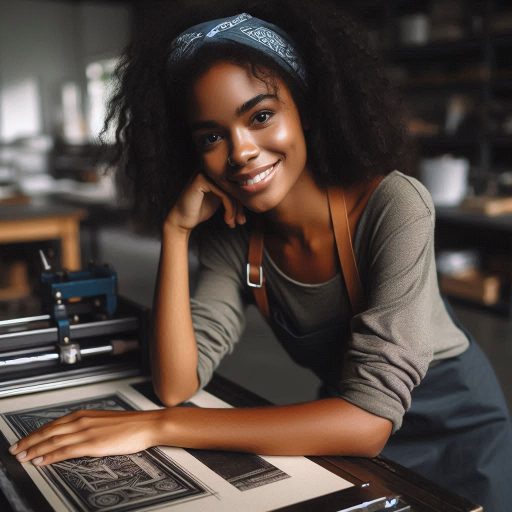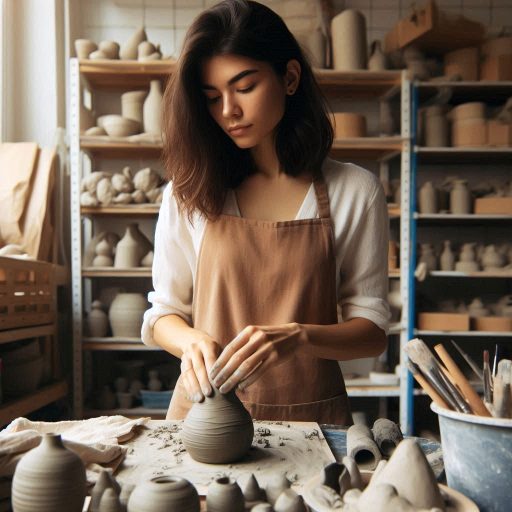Introduction
Printmaking plays a crucial role in fashion and textile design.
It transforms fabrics into unique, eye-catching canvases.
This process allows designers to bring their creative visions to life through intricate patterns and designs.
In the fashion industry, printmaking is more than just an artistic technique; it is a vital tool for innovation.
Designers use prints to set trends, create brand identity, and differentiate their collections.
Unique prints can turn ordinary garments into standout pieces, capturing the essence of contemporary style.
Various printmaking techniques are employed in fashion and textile design.
Screen printing, for example, involves pushing ink through a mesh screen onto fabric.
This method is popular for its versatility and ability to produce bold, vibrant designs.
Block printing uses carved blocks to stamp patterns onto textiles, offering a handcrafted touch.
Digital printing, a modern technique, allows for high-resolution images and complex patterns with precision.
Tools for printmaking in textiles include screens, blocks, rollers, and digital printers.
Each tool is chosen based on the desired effect and fabric type.
Designers select techniques that best suit their artistic goals and the functional needs of their designs.
Overall, printmaking adds depth and originality to fashion and textile design.
It enables designers to explore endless creative possibilities and shape the visual language of the fashion industry.
History of Printmaking in Fashion
Printmaking in fashion has a rich history that dates back centuries.
Let’s delve into the historical roots of printmaking in fashion and textile design.
Evolution of Printmaking
Printmaking has evolved from traditional methods like woodblock printing and screen printing to modern techniques such as digital printing and sublimation printing.
These advancements have revolutionized the way designers create patterns and prints for garments.
Transform Your Career Today
Unlock a personalized career strategy that drives real results. Get tailored advice and a roadmap designed just for you.
Start NowInfluence on Fashion Trends
Throughout history, printmaking has played a significant role in shaping fashion trends.
From the intricate patterns of the Renaissance to the bold graphics of the 1960s, prints have always been a standout feature in fashion design.
Designers have drawn inspiration from various printmaking techniques to create unique and eye-catching garments that set trends and make a statement.
Key Moments in History
One key moment in printmaking history that influenced fashion trends was the introduction of the paisley print in the West in the 18th century.
This distinctive teardrop-shaped motif became a popular design element in textiles and garments, symbolizing luxury and exoticism.
Another important moment was the rise of Art Deco prints in the 1920s, characterized by geometric shapes and bold colors.
These designs reflected the modernity and glamour of the period, influencing fashion trends of the time.
Printmaking in fashion continues to evolve and innovate, with designers pushing the boundaries of creativity and technology to create stunning prints that captivate and inspire.
Whether it’s hand-printed textiles or digitally printed patterns, printmaking remains a powerful tool for expression and storytelling in the world of fashion and textile design.
Read: Printmaking Inspirations: Nature and Landscape
Techniques of Printmaking
Printmaking is a versatile and dynamic process that allows designers in the fashion and textile industry to create unique and vibrant designs on various fabrics and materials.
There are several techniques used in printmaking, each offering its own distinct characteristics and results.
Screen Printing
Screen printing is a popular technique in which a design is transferred onto a mesh screen, with areas blocked off to create the desired pattern.
Ink is then pushed through the screen onto the fabric, creating a crisp, bold design.
This technique is widely used in creating graphic and multi-colored prints on textiles like t-shirts, dresses, and scarves.
Stella McCartney and Diane von Furstenberg use screen printing creatively.
They design eye-catching, innovative patterns that make bold statements.
Digital Printing
Digital printing is a modern technique that involves transferring a digital image directly onto fabric using specialized printers.
This method allows for intricate details and vibrant colors to be achieved, making it ideal for creating complex and detailed patterns on textiles.
Digital printing is often used in creating photo-realistic designs, floral prints, and abstract patterns on garments like blouses, skirts, and jackets.
Transform Your Career Today
Unlock a personalized career strategy that drives real results. Get tailored advice and a roadmap designed just for you.
Start NowBrands like Ted Baker and Peter Pilotto use digital printing.
They incorporate bold, colorful designs into their collections.
This technique showcases innovative possibilities in fashion.
Block Printing
Block printing is a traditional technique in which a design is carved into a block of wood, linoleum, or foam, which is then dipped into ink and pressed onto fabric to create a pattern.
This method allows for a handmade and artisanal quality in the prints, with each piece being unique.
Block printing is often used to create intricate and detailed patterns on textiles like sarees, scarves, and cushions.
Brands like Anokhi and Eka embrace block printing.
They showcase the beauty and craftsmanship of this technique.
Their collections celebrate traditional Indian textiles and designs.
Heat Transfer Printing
Heat transfer printing is a technique in which a design is printed on special transfer paper and then transferred onto fabric using heat and pressure.
This method allows for detailed and vibrant designs to be achieved, making it ideal for creating custom prints and personalized garments.
Heat transfer printing is often used in creating customized t-shirts, bags, and accessories.
Brands like Vans and Nike use heat transfer printing.
This method creates unique designs on their products.
Customers can customize items to express their style.
Printmaking enables this individual expression through creative designs.
Printmaking techniques offer diverse options for fashion designers.
Screen printing, digital printing, block printing, and heat transfer printing excel.
Designers can create innovative and expressive designs on various fabrics.
These techniques enable creative flexibility in textile design.
Transform Your Career Today
Unlock a personalized career strategy that drives real results. Get tailored advice and a roadmap designed just for you.
Start NowBy understanding the process and application of each technique, designers can leverage printmaking to elevate their collections and showcase their creativity in unique and impactful ways.
Read: Choosing the Right Paper for Printmaking
Inspiration and Design Process
Printmakers draw inspiration from various sources to create unique and innovative designs for fashion and textile.
Let’s delve into how these artists find inspiration and navigate the design process to bring their creations to life.
Finding Inspiration
- Nature: Many printmakers find inspiration in the beauty of nature, from intricate floral patterns to the textures of leaves and branches.
- Culture: Culture plays a significant role in printmaking, with artists drawing inspiration from traditional motifs, symbols, and textiles from different cultures around the world.
- Art: Art history and contemporary art are also common sources of inspiration for printmakers.
They may reinterpret famous paintings or draw from modern artistic movements. - Everyday Life: Printmakers may find inspiration in mundane objects or scenes from everyday life, using them as a starting point for their designs.
- Fashion Trends: Keeping up with the latest fashion trends can also inspire printmakers to create designs that are relevant and appealing to contemporary audiences.
Design Process
- Concept Development: The design process typically begins with brainstorming and sketching ideas to translate inspiration into tangible designs.
- Color Selection: Choosing the right color palette is crucial in printmaking.
Printmakers experiment with different color combinations to achieve the desired visual impact. - Pattern Exploration: Printmakers play with patterns, textures, and repeat motifs to create visually stimulating designs that stand out.
- Printing Techniques: There are various printing techniques available to printmakers, such as screen printing, block printing, and digital printing.
Each technique offers unique possibilities for creating different effects. - Prototyping: Printmakers often create prototypes to test their designs before final production, making adjustments to ensure the quality and integrity of the final product.
- Collaboration: Collaboration with textile designers, fashion designers, and manufacturers is common in the design process, as printmakers work together to bring their designs to market.
Experimentation with Patterns, Colors, and Textures
Printmakers experiment with different patterns by playing with scale, repetition, and variations to create dynamic and eye-catching designs.
Colors are essential in printmaking, as they can evoke emotions, set moods, and enhance the visual appeal of a design.
Textures add depth and dimension to printed fabrics, creating tactile experiences that engage the senses and elevate the overall design.
Mixing and matching patterns, colors, and textures allow printmakers to push the boundaries of traditional design, resulting in fresh and innovative creations.
Printmakers in fashion and textile design explore diverse sources.
They embrace experimentation in their design process. This approach creates remarkable prints.
Their work captivates the audience. They redefine textile artistry boundaries.
Read: Sculpture Materials: A Guide to Choosing the Best

Impact of Printmaking on Fashion Industry
Printmaking has significantly influenced the fashion industry in various aspects, from trends to sustainability practices.
Influence of printmaking on fashion trends and consumer preferences
Printmaking brings unique and eye-catching designs to clothing, setting trends and attracting consumers.
It allows designers to create distinctive patterns and motifs that appeal to different market segments.
Printed garments stand out in the fashion market, driving consumer demand for innovative and artistic designs.
Consumers often prefer printed textiles for their expressive and personalized aesthetic appeal.
How printmaking has revolutionized the way designers create and customize their collections
Printmaking offers designers a versatile medium to experiment with colors, textures, and patterns.
It allows for endless possibilities in creating unique and customized prints for each collection.
Designers can easily translate their creativity onto fabrics, adding a personal touch to their designs.
Transform Your Career Today
Unlock a personalized career strategy that drives real results. Get tailored advice and a roadmap designed just for you.
Start NowPrintmaking techniques enable designers to showcase their artistic vision and storytelling through fashion.
Role of printmaking in sustainability and ethical fashion practices
Printmaking allows for digital printing, which reduces water and chemical usage compared to traditional methods.
Designers can use environmentally friendly inks and dyes in printmaking, promoting sustainable practices.
By creating limited edition prints, designers can reduce waste and promote ethical production practices.
Printed textiles can be made from organic and recycled materials, supporting eco-friendly fashion initiatives.
Read: The Future of Printmaking in Digital Age
Collaboration in Printmaking
Successful Collaborations in Printmaking
Collaboration between printmakers, designers, and manufacturers is essential in creating innovative designs in fashion and textile.
Through teamwork and communication, these collaborations can lead to iconic collections that push boundaries and showcase creativity.
Alexander McQueen and Damien Hirst
One of the most notable collaborations in the fashion world was between Alexander McQueen and artist Damien Hirst.
McQueen’s Spring/Summer 2009 collection dazzled with digitally printed dresses.
Hirst‘s butterfly designs adorned these dresses.
This fusion created a stunning visual impact. The collection blurred lines between fashion and art.
Marimekko and Maija Isola
Finnish design company Marimekko is renowned for its bold and colorful prints, with many designs created by printmaker Maija Isola.
Isola’s collaborations with Marimekko led to the creation of timeless patterns that are still popular today, showcasing the power of collaboration in printmaking.
The Role of Teamwork and Communication
Teamwork and communication are vital components in bringing printmaking designs to life in the fashion and textile industry.
Printmakers, designers, and manufacturers must work together harmoniously to ensure the vision and concept of a collection are realized to their fullest potential.
Sharing Ideas and Vision
Effective communication allows printmakers, designers, and manufacturers to share ideas, inspiration, and vision for a collection.
By collaborating and aligning their creative concepts, they can produce cohesive collections that resonate with consumers and push the boundaries of printmaking in fashion.
Problem-Solving and Innovation
Collaboration fosters problem-solving and innovation in the design process. Printmakers bring their technical expertise, designers offer creative concepts, and manufacturers provide input on production feasibility.
By working together, they can overcome challenges, experiment with new techniques, and create unique prints that stand out in the market.
Transform Your Career Today
Unlock a personalized career strategy that drives real results. Get tailored advice and a roadmap designed just for you.
Start NowCollaboration in printmaking is a dynamic and transformative process that brings together diverse talents and perspectives to create groundbreaking designs in fashion and textile.
By highlighting successful collaborations and emphasizing the importance of teamwork and communication, the industry can continue to innovate and inspire with each new collection.
See Related Content: Differences Between UX and UI Design Explained
Cultural Influence on Printmaking
Printmaking in fashion and textile design is heavily influenced by different cultures and traditions.
The rich history and diverse heritage of various societies around the world serve as a well of inspiration for designers looking to create unique and culturally significant prints.
Examination of Cultural Inspirations
Exploring how different cultures influence printmaking designs in fashion and textile design.
Explore motifs and symbols in diverse cultures.
Analyze how cultures incorporate these elements into prints.
Examine prevalent techniques and their cultural significance.
Understand how symbols shape print designs across different societies.
Analyzing the impact of cultural diversity on the evolution of printmaking in the fashion industry.
Significance of Cultural Incorporation
- Integrating cultural motifs, symbols, and techniques adds depth and meaning to print designs.
- Creating prints that represent different cultures helps in fostering diversity and cross-cultural understanding.
- Respecting and celebrating cultural heritage through printmaking promotes cultural exchange and appreciation.
Examples of Successful Integrations
Stella Jean, an Italian-Haitian designer, incorporates traditional African prints in her collections, creating a fusion of cultures.
Manish Arora, an Indian designer, infuses vibrant Indian textiles and motifs into his designs, showcasing his cultural roots.
Dries Van Noten, a Belgian designer, often draws inspiration from different cultures, creating eclectic and globally influenced prints.
Cultural influence in printmaking not only adds a unique aesthetic to fashion and textile design but also serves as a means of cultural expression and appreciation.
By incorporating elements from diverse cultures, designers can create prints that resonate with people from all walks of life, celebrating the beauty and richness of global heritage.
Future Trends in Printmaking
Upcoming trends in printmaking for fashion and textile design
Printmaking in fashion and textile design evolves rapidly.
Future trends will shape the industry significantly.
Innovations will drive new design techniques and aesthetics.
Technology will enhance print quality and customization options.
Transform Your Career Today
Unlock a personalized career strategy that drives real results. Get tailored advice and a roadmap designed just for you.
Start NowSustainability will lead to eco-friendly print materials and processes.
Designers will explore interactive and dynamic print applications.
One of the most significant trends in printmaking for fashion and textile design is the shift towards eco-friendly printing methods.
As environmental awareness continues to grow, designers and printmakers are exploring sustainable alternatives to traditional printing techniques.
This includes using water-based inks, organic dyes, and recycled materials to minimize the environmental impact of their creations.
How technology is shaping the future of printmaking and its impact on the fashion industry
Technological advancements are also playing a key role in shaping the future of printmaking.
Digital innovations such as 3D printing, digital textile printing, and sublimation printing are revolutionizing the way designs are created and produced.
These technologies allow for greater precision, faster production times, and increased customization options, giving designers more flexibility and creative freedom.
How printmakers are adapting to changing consumer demands and market trends
The impact of technology on the fashion industry cannot be understated.
With the rise of e-commerce and social media, consumers are more connected and informed than ever before.
Printmakers and designers must adapt to these changing consumer demands by creating dynamic and engaging designs that resonate with their target audience.
This means staying ahead of trends, experimenting with new techniques, and embracing innovation to stay competitive in the market.
As consumer preferences and market trends continue to evolve, printmakers must be adaptable and responsive to stay relevant in the industry.
Stay updated with technology, sustainability, and consumer trends.
This keeps printmakers ahead in fashion and textile design.
In a nutshell, the future of printmaking in fashion and textile design is bright and full of exciting possibilities.
Embrace eco-friendly practices. Use technology‘s power.
Stay attuned to consumer demands. Push boundaries in printmaking.
Create designs that captivate audiences worldwide.
Printmaking’s future hinges on practitioners’ imagination and creativity.
Transform Your Career Today
Unlock a personalized career strategy that drives real results. Get tailored advice and a roadmap designed just for you.
Start NowArtists continually push boundaries in this evolving field.
Their innovation defines printmaking’s limitless potential.
Conclusion
Printmaking in fashion and textile design offers a unique and creative approach to creating innovative patterns and designs.
By using various printmaking techniques such as screen printing, block printing, and digital printing, designers can add depth, texture, and visual interest to their creations.
Furthermore, printmaking allows designers to express their creativity and individuality, resulting in one-of-a-kind pieces that stand out in the competitive fashion industry.
The craftsmanship and attention to detail involved in printmaking designs add value and sophistication to fashion and textile products.
Printmaking plays a crucial role in the fashion and textile design industry by offering a versatile and artistic way to create visually stunning patterns and designs.
It encourages designers to push boundaries, experiment with different techniques, and showcase their unique artistic flair.
As consumers, we should appreciate the artistry and dedication that goes into creating printmaking designs.
By supporting designers who incorporate printmaking into their work, we can help promote creativity, innovation, and craftsmanship in the fashion industry.




